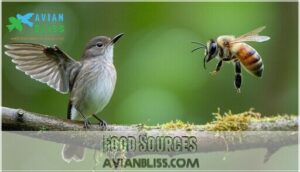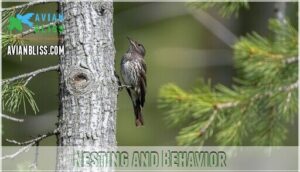This site is supported by our readers. We may earn a commission, at no cost to you, if you purchase through links.
 You’ll recognize the olive sided flycatcher by its distinctive "Quick, three BEERS!" call echoing from tall treetops.
You’ll recognize the olive sided flycatcher by its distinctive "Quick, three BEERS!" call echoing from tall treetops.
This compact songbird perches boldly on exposed dead branches, showing off its olive-brown back and crisp white throat that resembles a vest.
They’re summer residents in North American coniferous forests, preferring open woodlands near water with prominent snags for hunting insects.
While challenging to distinguish from other flycatchers, their confident posture and habit of claiming the highest perches make identification easier.
These aerial acrobats snatch flying insects with impressive precision, returning to the same exposed perch repeatedly.
Understanding their specific habitat preferences and behavioral quirks reveals why spotting techniques matter more than field marks alone, and their ability to snatch insects with impressive precision is a notable trait, making them skilled aerial acrobats.
Table Of Contents
- Key Takeaways
- Olive Sided Flycatcher Overview
- Habitat and Range
- Diet and Foraging
- Nesting and Behavior
- Conservation Status
- Frequently Asked Questions (FAQs)
- Where do olive-sided flycatchers live?
- Why is the Olive-sided Flycatcher endangered?
- What bird says quick 3 beers?
- What is an interesting fact about the Olive-sided Flycatcher?
- Where do olive-sided flycatchers winter?
- What is the difference between olive-sided and pewee?
- What is the nesting habit of the Olive-sided Flycatcher?
- How long do olive-sided flycatchers typically live?
- What are the main predators of olive-sided flycatchers?
- Can olive-sided flycatchers be kept as pets?
- Conclusion
Key Takeaways
- You’ll recognize the olive-sided flycatcher by its distinctive "Quick, three BEERS!" call and white vest-like chest pattern that contrasts with dark, mottled sides
- You’ll find these barrel-chested birds perched high on dead branches in northern coniferous forests, where they dart out to catch flying insects with impressive precision
- You’re witnessing a species in serious decline—populations have dropped 74-79% over 50 years due to habitat loss, pesticide impacts, and challenges during their epic 12,700-mile migration to Central and South America
- You can help by supporting habitat protection efforts and pesticide reduction, since these aerial acrobats depend on healthy forests with standing snags and abundant flying insects for survival
Olive Sided Flycatcher Overview
You’ll recognize an Olive-sided Flycatcher by its stocky, barrel-chested build and distinctive "vest" pattern—dark mottled sides with a bright white stripe down the center of its chest.
This compact bird sits upright on high perches with its big head and heavy bill, looking somewhat like it’s wearing a formal waistcoat while keeping watch over its territory.
Species Identification
You’ll spot this stocky, barrel-chested flycatcher by its distinctive "waistcoat" appearance—dark, mottled sides contrasting with a bright white chest stripe.
Unlike similar species, it’s larger than a Western Wood-Pewee but smaller than a Western Kingbird, making field marks essential for bird identification.
Key distinguishing features include:
- Heavy bill and large head – gives it a big-headed, short-tailed silhouette
- White wing tufts – visible patches above the wings when perched upright
- Notched tail – square-tipped rather than forked like other flycatcher species
Physical Characteristics
You’ll notice the olivesided flycatcher’s distinctive plumage details that set it apart from other birds.
The mottled sides create a striking contrast against the white chest stripe, giving it a waistcoat appearance.
Bill morphology features a heavy, long structure perfect for catching insects.
Wing length extends beyond the tail, while the notched tail shape adds to its compact profile.
| Feature | Description |
|---|---|
| Chest Pattern | White stripe down center, dark mottled sides |
| Bill Structure | Heavy, long, grayish coloration |
| Wing Design | Long wings extending past tail |
| Color Scheme | Grayish-brown with white markings |
| Distinctive Mark | White tuft above wing (sometimes visible) |
Size and Shape
Picture a stocky flycatcher that’s built like a tiny linebacker.
Looking at the paragraph’s playful, descriptive tone that compares the bird to a "tiny linebacker," here’s a matching blockquote:
Built like nature’s feathered bouncer, ready to defend its treetop territory.
You’ll recognize the Olive-sided Flycatcher by its barrel-chested body proportions and oversized head that makes its tail appear surprisingly short.
This bird size falls between a sparrow and robin at 7-8 inches long.
Wing length creates the illusion of even shorter tail markings, while its heavy bill morphology gives it a distinctive silhouette.
Birds maintain high energy levels thanks to their efficient respiratory system.
The bird wingspan and sturdy plumage details make identification straightforward from considerable distances, with its heavy bill being a notable feature.
Habitat and Range
You’ll find these remarkable flycatchers in two vastly different worlds throughout the year.
They breed in northern coniferous forests, bogs, and burned areas, then make an epic journey to winter in the mountain forests of Central and South America.
Breeding Habitat
Finding your breeding olive-sided flycatcher means seeking out northern coniferous forests where these barrel-chested birds claim their territories.
They’re drawn to forest edges and openings where site fidelity keeps them returning annually to proven spots.
Look for them in these prime breeding locations:
- Burned areas and recent clearcuts with standing snags for perching
- Mountain habitats ranging from sea level to over 10,000 feet elevation
- Bog edges and meadow margins within coniferous forest boundaries
Their nesting elevation preferences vary widely, but bird nesting success depends on finding the perfect balance between open hunting grounds and protective tree cover for raising young.
Habitat loss can impact nesting site availability, influencing breeding success.
Wintering Habitat
When winter arrives, you’ll find Olive-sided Flycatchers escaping to warmer climates in Central America and South America.
When winter beckons, these aerial acrobats escape to tropical mountain forests, trading snow for warmth.
These birds seek forest edges and gaps at elevations between 3,300 to 6,600 feet, where food availability remains steady.
Unfortunately, tropical deforestation threatens their wintering grounds, contributing to significant habitat loss that’s impacting populations across their range.
Migration Patterns
These remarkable birds undertake one of North America’s most demanding journeys, with some Alaskan breeders traveling 12,700 miles annually to reach Bolivian wintering grounds.
Migration timing follows strict patterns—spring arrivals peak in late May, while fall departures begin surprisingly early in August.
Stopover ecology proves essential, as birds rely on specific refueling sites throughout their route.
Climate impacts increasingly threaten this precisely-timed system, creating conservation challenges for maintaining stable migration patterns.
These flycatchers are experiencing a significant population decline, with a 78% decrease since 1970, as reported in this significant population decline article.
Diet and Foraging
You’ll find that Olive-sided Flycatchers have quite the appetite for flying insects, making them skilled aerial hunters who prefer bees, wasps, ants, and beetles.
They’ll perch high on dead branches or snags, then dart out to snatch their prey mid-flight before returning to the same spot to watch for their next meal, showcasing their skill as aerial hunters.
Food Sources
You’ll find the Olivesided Flycatcher’s diet centers on flying insects, with bees, wasps, and ants making up 74-83% of their seasonal intake.
These Tyrant Flycatchers show remarkable Prey Selection, targeting honeybees so heavily they sometimes fill entire stomachs.
Insect Abundance drives Dietary Shifts—beetles now dominate some regional diets where hymenoptera once ruled.
Pesticide Impact threatens their Foraging Ecology by reducing available prey across breeding grounds.
As a species, the Olive-sided Flycatcher is classified as near-threatened due to declining populations.
Foraging Techniques
You’ll spot this aerial insectivore practicing classic perch hunting from dead snags and tall trees.
Watch as it launches from its high vantage point, snatches flying insects mid-air, then returns to the same perch.
This prey selection strategy maximizes foraging success in open areas.
Burned habitats provide ideal hunting grounds with exposed perches and abundant insect activity.
The bird feeding behavior shows remarkable precision in these calculated aerial strikes.
Feeding Habits
Throughout the year, you’ll notice distinct changes in their seasonal diet patterns that reflect both availability and nutritional needs.
These aerial acrobats adjust their insect prey preferences based on foraging altitude and environmental conditions, though pesticide impact increasingly threatens their food sources.
Their hunting success relies on aerial feeding strategies.
Here’s what shapes their feeding behavior:
- Prey size selection – They target larger flying insects like beetles and dragonflies during peak breeding season for maximum energy return
- Altitude-based hunting – Higher perches yield different insect types, with wasps and bees more common at canopy level
- Weather-dependent timing – Cool mornings and warm afternoons trigger different insect activity, influencing their flycatcher characteristics and hunting success
Nesting and Behavior
When you observe an Olive-sided Flycatcher during breeding season, you’ll notice their strong territorial instincts and specific nesting preferences that make them quite predictable once you know what to look for.
These birds demonstrate remarkable site fidelity, often returning to the same breeding territory year after year, which makes finding them easier if you’ve spotted one before, showcasing their predictable nature.
Nest Placement
You’ll find Olive-sided Flycatcher nests positioned high in conifer trees, typically 5-70 feet above ground on horizontal branches.
These birds show strong site fidelity, returning to familiar bird territory year after year.
Their conifer preference and specific branch orientation help protect against bird predators, though nest height varies based on available bird habitats and local bird nesting habits within each bird nest site, which is an example of strong adaptation to their environment, and a key factor in their nesting habits.
Nest Description
The Olivesided flycatcher constructs a shallow, cup-shaped nest using fine twigs, rootlets, and conifer needles.
Nest construction involves weaving materials into a compact structure, typically measuring 3-4 inches across.
Nest camouflage comes naturally through lichen and moss decoration, which helps these bird nest sites blend seamlessly with surrounding branches, protecting bird eggs and bird young.
The female’s fastidious nest materials selection guarantees durability, though specific nest components can be purchased.
The female’s fastidious nest materials selection guarantees durability, though nest longevity rarely extends beyond one breeding season due to the species’ bird behavior of building fresh structures annually.
Nesting Facts
These remarkable flycatchers showcase fascinating nesting patterns that highlight their specialized habitat needs.
Nest construction occurs exclusively by females, who carefully select horizontal coniferous branches averaging 5-70 feet high. Egg incubation lasts 15-19 days, with fledgling success rates varying dramatically across regions.
- Nest predators like Gray Jays and Red Squirrels pose constant threats to bird eggs
- Breeding territory defense spans 10-20 hectares of prime coniferous forest habitat
- Bird behavior includes replacement clutches when initial nests fail completely
Territorial Behavior
Male Olive-sided Flycatchers establish large territories that they’ll defend with fierce determination.
You’ll witness aggressive displays including wing-fluttering, bill-snapping, and chasing rivals from prime perches.
Their distinctive calls serve as both territorial markers and warnings to intruders.
These birds show remarkable site fidelity, returning to the same breeding grounds year after year.
| Territory Aspect | Behavior Details |
|---|---|
| Territory Size | Large areas with multiple high perches for efficient foraging |
| Defense Strategies | Wing displays, chasing, and persistent vocalizations against rivals |
| Vocalizations | Loud calls from prominent perches to mark boundaries |
| Site Fidelity | Return to same breeding territories annually |
Conservation Status
The Olive-sided Flycatcher faces serious conservation challenges that you should know about.
This species has experienced a dramatic 75% population decline over the past 50 years, earning it Near Threatened status on the IUCN Red List.
Threats to Population
Multiple factors threaten Olive-sided Flycatcher populations, driving an alarming 80% population decline over fifty years.
Habitat Loss from deforestation destroys both breeding and wintering grounds. Insecticide Use reduces flying insect prey availability. Poor Forest Management practices eliminate preferred snag habitats.
Climate Change shifts insect emergence timing and shrinks suitable habitat ranges. Migration Risks increase mortality during their epic 12,700-mile journeys between continents.
The combination of these threats, including Habitat Loss, results in a significant decline in Olive-sided Flycatcher populations.
Conservation Actions
Several conservation actions tackle the Olive-sided Flycatcher’s steep population decline.
Habitat Protection preserves critical breeding sites, while Fire Management uses prescribed burns to create suitable nesting areas.
Pesticide Reduction protects their insect prey base.
International Collaboration addresses habitat loss on wintering grounds through partnerships.
Mortality Reduction focuses on migration route conservation.
Using safe pesticide alternatives can further help protect the flycatcher’s food source.
These coordinated conservation actions help combat climate change impacts and address the species’ IUCN Red List status.
Current Status
Unfortunately, the Olive-sided Flycatcher’s conservation status tells a sobering story.
Population trends show a devastating 74-79% decline over fifty years, earning it Near Threatened status on the IUCN Red List.
Habitat loss on wintering grounds, combined with breeding territory destruction, continues driving this bird species decline.
Understanding the IUCN Red List criteria is essential for prioritizing conservation efforts.
Despite conservation actions, research gaps remain regarding specific threats and effective protection strategies for this declining flycatcher.
Research and Protection Efforts
Thorough population monitoring through GPS tracking reveals Alaska flycatchers travel 20,500 kilometers annually.
Habitat restoration focuses on maintaining burned forests with snags, while pesticide reduction addresses insect prey decline.
Climate impacts threaten breeding cycles as international collaboration protects wintering grounds.
Conservation actions target this IUCN Red List species’ 74% population decline through coordinated bird conservation efforts.
Frequently Asked Questions (FAQs)
Where do olive-sided flycatchers live?
You’ll find these birds in northern coniferous forests during breeding season, from sea level to 10,000+ feet elevation.
They prefer forest edges, burns, bogs, and meadows with tall trees, then migrate to Central and South American mountain forests for winter.
Why is the Olive-sided Flycatcher endangered?
Before telegraphs connected distant lands, you’d find these barrel-chested flycatchers thriving in northern forests.
Now they’re near threatened because habitat loss on wintering grounds, deforestation, pesticides, and their epic 12,700-mile migration create perfect storm conditions.
What bird says quick 3 beers?
You’ll hear the Olive-sided Flycatcher’s distinctive "quick, three beers!" call echoing through coniferous forests.
This stocky bird’s emphatic song sounds remarkably like someone shouting for refreshments, making it instantly recognizable to birders with its distinctive call.
What is an interesting fact about the Olive-sided Flycatcher?
Unlike its flashy kingbird cousins, this barrel-chested flycatcher undertakes one of North America’s longest migrations—some individuals travel over 12,700 miles annually between northern breeding grounds and South American wintering areas.
Where do olive-sided flycatchers winter?
You’ll spot these hardy birds escaping harsh northern winters by heading to Central and South America’s mountain forests, where they settle at elevations between 3,300 to 6,600 feet.
What is the difference between olive-sided and pewee?
You’ll recognize olive-sided flycatchers by their stocky, barrel-chested build and distinctive white chest stripe, while pewees appear smaller, more slender, with less prominent markings and different perching behavior.
What is the nesting habit of the Olive-sided Flycatcher?
Like architects building sky-high dreams, you’ll find females constructing open-cup nests on horizontal branches fifteen to seventy feet up.
They choose tall conifers, often at forest edges, weaving twigs and rootlets into secure cradles for their precious eggs.
How long do olive-sided flycatchers typically live?
You can’t typically expect these birds to stick around for a decade.
The maximum recorded lifespan is about 11 years in the wild, though most don’t reach this age due to migration challenges and habitat pressures.
What are the main predators of olive-sided flycatchers?
You’ll find squirrels, particularly red squirrels, among the biggest threats to nesting birds, aggressively raiding eggs and chicks.
Red squirrels pose significant nest predation risks, while Gray Jays and Common Ravens also prey on nests.
These birds defend their territories with remarkable intensity.
Can olive-sided flycatchers be kept as pets?
Caging wild songbirds breaks the sacred bond between creature and sky.
You can’t legally keep olive-sided flycatchers as pets—they’re protected under federal law, requiring specialized care that’s impossible in captivity.
Conclusion
Recent research challenges the theory that olive sided flycatchers are declining solely due to habitat loss – pesticide accumulation in their insect prey may be equally devastating.
You’ve learned to identify this distinctive flycatcher by its bold perching habits, white vest-like throat, and unmistakable "Quick, three BEERS!" call.
While their conservation status remains concerning, understanding their specific needs helps you become a better observer and advocate.
When you spot an olive sided flycatcher next summer, you’re witnessing a species fighting for survival in our changing forests.
- https://www.thelandbetween.ca/the-land-between-species-at-risk/olive-sided-flycatcher/
- https://ucsccampusreserve.ucsc.edu/media1/olive-sided-flycatcher
- https://www.allaboutbirds.org/guide/Olive-sided_Flycatcher/maps-range
- https://www.oregonconservationstrategy.org/strategy-species/olive-sided-flycatcher/
- https://partnersinflight.org/species/olive-sided-flycatcher/











